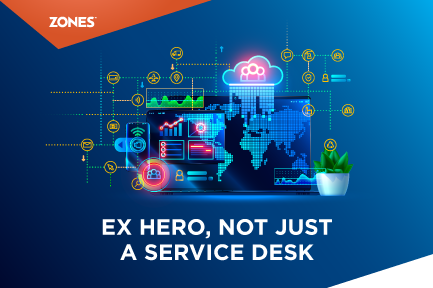The Critical Role of the Service Desk in Building EX-Focused Workplaces
In the past few years, the definition of the workplace has gone beyond the physical location to virtual space. With the shift from fully remote to...
3 min read
![]() Zones
:
Sep 26, 2024 8:38:02 AM
Zones
:
Sep 26, 2024 8:38:02 AM

Employees expect their IT support to be quick. However, traditional IT assistance often involves long wait times. This is where self-service IT enters the picture. With this strategy, staff members may resolve tech issues on their own, submit service requests, and locate resources without constantly contacting IT.
In this article, we'll examine how self-service IT may revolutionize workplace productivity and provide a practical illustration of why this model is critical for the future using the Zones Self-Service IT Solution.
Employees file a ticket, and IT teams reply based on their availability under the typical reactive IT support model. It may result in:
IT teams and staff may become frustrated because of these inefficiencies, which can hamper work.
Organizations cannot afford to have their performance hampered by inefficient IT systems. When IT support becomes a bottleneck, it affects more than just the speed at which issues are resolved. It can also lead to:
Self-service IT is a proactive solution that enables staff members to take care of routine IT tasks without waiting for assistance. It achieves this by utilizing automation, user-friendly portals, and on-demand resources. Some of the features of self-service IT include:
Self-service IT reduces the load on IT professionals, expedites issue resolution, and boosts productivity by enabling staff members to do basic activities on their own.
The Zones Self-Service IT Solution explains the impact of self-service IT. Before the introduction of self-service, many businesses experienced overworked IT teams and slow response times for basic requests. After self-service IT was implemented, organizations saw the following benefits:
This shift not only improved overall efficiency but also empowered employees to take control of their IT needs, resulting in a more productive and satisfied workforce.
Self-service IT is not just a trend. Empowering employees to manage their own IT needs will be crucial to maintaining productivity and cutting expenses as firms continue to change. Businesses may simplify processes, reduce workloads for IT staff, and provide consumers with quicker, more dependable service by using the appropriate self-service solutions.
Visit the Zones Innovation Center to learn more about how self-service IT may benefit your company. Here, we're driving the transformation of office productivity. Visit our comprehensive use case to find out more about our self-service solution and how it can empower your employees.
FAQs
Q1: What types of tasks can self-service IT handle?
A1: Self-service IT can automate tasks like password resets and software installations and provide access to knowledge bases for troubleshooting.
Q2: How does self-service IT benefit IT teams?
A2: It reduces the number of tickets IT staff need to handle, allowing them to focus on more complex issues and strategic initiatives.
Q3: Is self-service IT difficult to implement?
A3: The implementation process depends on the existing infrastructure, but with the right tools, most organizations can set up self-service IT in a matter of weeks.
Related Reading:

In the past few years, the definition of the workplace has gone beyond the physical location to virtual space. With the shift from fully remote to...

The optimal performance of data-bearing IT assets is crucial to an organization’s operational efficiency. This is why these assets require a secure...

In 2025, sustainability is no longer a corporate checkbox. It is a business imperative. Every function is being asked the same question: what are we...